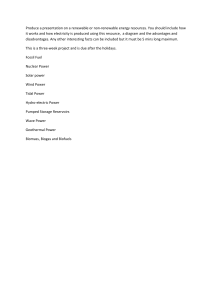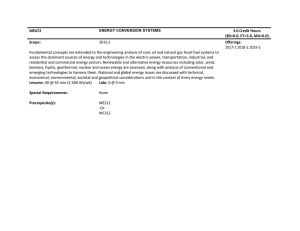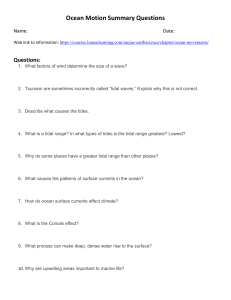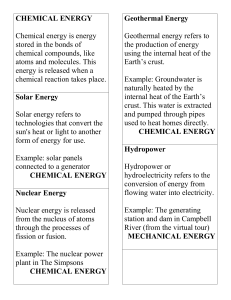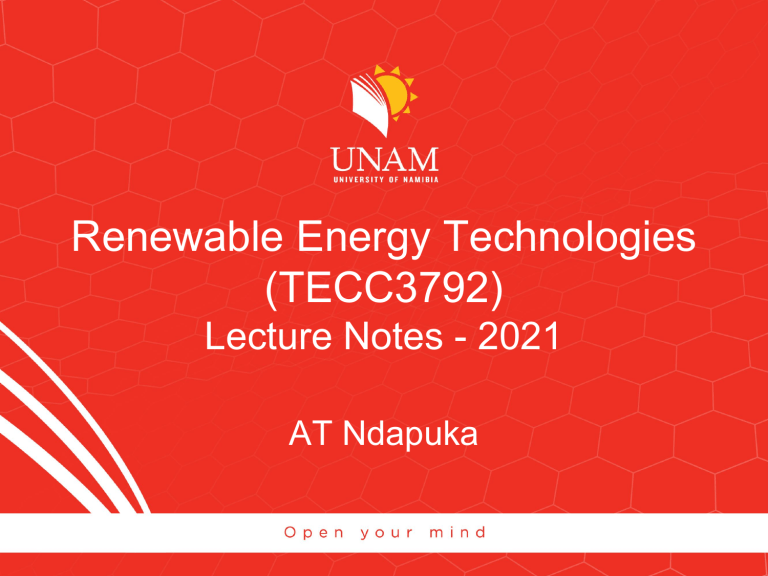
Renewable Energy Technologies (TECC3792) Lecture Notes - 2021 AT Ndapuka CH7 Outline Other forms of Renewable Energy • • • • • • Introduction Wave Energy Tidal Power Hydroelectric Power • Pumped Hydro Biomass for Electricity Geothermal AT Ndapuka TECC3792 Introduction RE Technologies AT Ndapuka TECC3792 Introduction Present and Future Trends • Global Installed Capacity AT Ndapuka TECC3792 Introduction Present and Future Trends (cont’d) • Global Installed Capacity (cont’d) 2019 Additions Total power capacity rose 8.4% 2,588 GW including hydropower Non hydropower: 14.7% increase 5% growth in biofuel production AT Ndapuka TECC3792 Introduction Present and Future Trends (cont’d) • Global Installed Capacity (cont’d) AT Ndapuka TECC3792 Other RE Forms Wave Energy • Ocean energy - Energy captured from ocean waves, tides, currents, salinity gradients and ocean temperature differences. • Solar energy on earth causes varying temperatures, which in turn cause winds to blow and create waves on the surface of the ocean. • These waves are a powerful source of energy. • Ocean waves are a more predictable resource with a higher energy density compared to solar and wind. However, harvesting this energy is a challenge. • Wave energy converters capture the energy of surface waves to generate electricity. • Wave energy projects are still in pilot stage. AT Ndapuka TECC3792 Other RE Forms Wave Energy (cont’d) • Wave Energy Resource • If the waves are assumed to be sinusoidal, then their power per meter is given by [W/m]: 𝜌𝑔2 𝐻2 𝑇 𝑃= 32𝜋 • Where: 𝜌 − density of sea water (1025 kg/m3) 𝑔 − gravitational acceleration (9.8 m/s2) 𝐻 − trough-to-crest height (m) 𝑇 − wave period (s) • However, actual waves in the ocean are more complex to be represented in this way. Several factors still need to be considered. AT Ndapuka TECC3792 Other RE Forms Wave Energy (cont’d) • Harvesting methods AT Ndapuka Terminator Attenuator Point Absorbers Overtopping Device TECC3792 Other RE Forms Methods of harvesting wave energy • Terminator – partially submerged structures oriented perpendicular to the direction of the wave to force water into the device. • Incoming wave compresses the air trapped inside a chamber which in turn spins the turbine. AT Ndapuka TECC3792 Other RE Forms Methods of harvesting wave energy (cont’d) • Attenuator – These are long devices aligned parallel to the • • direction of the wave such that their front end points into the oncoming wave. Hydraulic pumps convert the flexing into shaft power for the generator. Works with both vertical and horizontal waves. Pelamis Attenuator AT Ndapuka TECC3792 Other RE Forms Methods of harvesting wave energy (cont’d) • Point Absorbers –These are floating platforms, not oriented in a • particular way toward the waves. They utilise rise and falls of waves to run the generator. AT Ndapuka TECC3792 Other RE Forms Methods of harvesting wave energy (cont’d) • • Overtopping Device – Made up of a reservoir, and water is forced onto the resevoir by the waves. Water is then rejected from the reservoir through the turbine. • Self Study Topic: Predicting Wave Energy Performance (8.3.3) AT Ndapuka TECC3792 Other RE Forms Wave Energy (cont’d) Advantages Disadvantages • It is highly predictable compared to wind and solar. • It is a renewable form of energy. • It is environmental friendly. • High initial capital. • Equipment rating and wave magnitude complications. • It can cause damage to sea life ecosystem. • Location disadvantage. • May lead to high transmission losses. • Noise and visual concerns. AT Ndapuka TECC3792 Other RE Forms Tidal Power • Tides are created by the gravitational effect of the sun and the moon on the earth. • The occurrence of tides is highly predictable, but harvesting tidal energy is a serious challenge. • Tidal energy is produced through the use of tidal energy generators which are placed in areas with high tidal movements. • Generators are designed to capture the kinetic motion of the ebbing and surging of ocean tides in order to produce electricity. • Tidal barrages are dams that cross tidal estuaries and capture energy as tides ebb and flow. • Tidal Range - The difference between high and low tides. Must be at least 5 meters. AT Ndapuka TECC3792 Other RE Forms Tidal Power (cont’d) • Spring tides (max) • Neap tides (min) Source: Alternative Energy Tutorials AT Ndapuka TECC3792 Other RE Forms Tidal Power (cont’d) • Tidal Energy is more developed than wave energy, about 536 MW of installed capacity by 2016. • Major plants in operation: • 254 MW Sihwa plant in the Republic of Korea (2011). • 240 MW La Rance tidal power station in France (1966). • 320 MW Swansea Bay Tidal Lagoon in Wales, was proposed at a cost of £1.3 billion. The construction was postponed because UK gov rejected funding the project. • At the start of 2017, China released its 13th Five-Year Plan on Ocean Energy, which targets 50 MW of installed capacity by 2020. AT Ndapuka TECC3792 Other RE Forms Tidal Technologies Barrages or Dams Tidal Fences Tidal Turbines AT Ndapuka TECC3792 Other RE Forms Tidal Technologies (cont’d) • Barrages or Dams • They use the difference in the vertical height between the incoming high tides and the outgoing low tides. • As the tide ebbs and flows, sea water is allowed to flow in or out of the reservoir. AT Ndapuka TECC3792 Other RE Forms Tidal Power Technologies • Barrages or Dams (cont’d) Source: Alternative Energy Tutorials AT Ndapuka TECC3792 Other RE Forms Tidal Power Technologies (cont’d) • Tidal Fences • These are vertical axis turbines mounted in a fence or row placed on the sea bed. AT Ndapuka TECC3792 Other RE Forms Tidal Power Technologies (cont’d) • Tidal Turbines • Tidal turbines are similar to wind turbines. • They are normally placed on the sea floor where the tidal flow is strong. • They are heavier than WT. • Also expensive to build. AT Ndapuka TECC3792 Other RE Forms Tidal Power (cont’d) • Tidal Turbines: Operating Principle • A tidal current generator operates exactly in the same way as the wind turbine. • The only difference is that here, the driving force is water which is more denser than air. • Therefore, the wind equations also do apply here. • Power in the water: 1 𝑃𝑤 = 𝜌𝐴𝑣 3 2 where AT Ndapuka 𝜌 = 1025 kg/m3 TECC3792 Other RE Forms Tidal Power (cont’d) Advantages • It is a renewable energy resource. • Produces free and green energy. • Low visual impact as the tidal turbines are mainly if not totally submerged beneath the water. • Low noise pollution as any sound generated is transmitted through the water. • High predictability as high and low tides can be predicted years in advance, unlike wind. • Tidal barrages provide protection against flooding and land damage. • Large tidal reservoirs have multiple uses and can create recreational lakes and areas. AT Ndapuka TECC3792 Other RE Forms Tidal Power (cont’d) Disadvantages • Disturbs sea life migration. • Build up of silt, sediments and pollutants within the tidal barrage. • Requires a suitable site, where the tides are consistently strong. • Higher capital costs (construction and maintenance costs/W). • High power distribution costs. Long undersea cables. • Intermittency in nature. • Danger to fish and other sea-life as they get stuck in the barrage or sucked through the tidal turbine blades. AT Ndapuka Other issues • Higher payback periods. • Therefore, not cost effective compared to conventional sources. TECC3792 Other RE Forms Hydro Power • Hydro forms up a significant part of the global electricity supply. • Over 1 TW installed global capacity (16.5%). • The largest hydro plants are Three Gorges 22.4 GW (China) and Itaipu 14 GW (Brazil). • About 350 GW installed in China. • 330 MW installed in Namibia, Ruacana Hydro Power Station. • Hydro is a mature and established technology. • It is flexible; can provide baseload power, peaking power, spinning reserve or even storage. • Small hydro is becoming attractive and cost effective. AT Ndapuka TECC3792 Other RE Forms Hydro Power (cont’d) • Global Capacity • 19.4 GW were added to reach a total of 1,170 GW • China continues to lead the market. Hydropower Global Capacity, Shares of Top 10 Countries and Rest of World, 2020 (GSR2021) AT Ndapuka TECC3792 Other RE Forms Hydro Power (cont’d) • Hydropower Configurations 1. Run-of-the-river plants 2. Hydro with Storage 3. Pumped Hydro AT Ndapuka TECC3792 Other RE Forms Hydro Power (cont’d) • Operating Principle • Potential, pressure and kinetic energy associated with hydro plants. • Energy Head: (pressure and velocity head) 𝑝 𝑣2 𝐸𝑛𝑒𝑟𝑔𝑦 𝐻𝑒𝑎𝑑 = 𝑧 + + 𝛾 2𝑔 • Where: 𝑧 − elevation above reference height [m]. 𝑝 − pressure [N/m2] 𝛾 − specific weight [N/m3] 𝑣 − average velocity [m/s] g − gravitational acceleration [9.81 m/s2) AT Ndapuka TECC3792 Other RE Forms Hydro Power (cont’d) • Operating Principle (cont’d) • Q – Flow rate [m3/s) • HG – Gross Head [m] • Without considering losses: 𝑃 = 9.81 × 𝑄 × 𝐻𝐺 [kW] • Considering losses: 𝑃 = 9.81 × 𝜂 × 𝑄 × 𝐻𝑁 [kW] • 𝐻𝑁 = 𝐻𝐺 − 𝑃𝑖𝑝𝑖𝑛𝑔 𝑙𝑜𝑠𝑠𝑒𝑠 AT Ndapuka TECC3792 Other RE Forms Hydro Power (cont’d) • Operating Principle (cont’d) • H – Gloss Head [m] AT Ndapuka TECC3792 Other RE Forms Hydro Power (cont’d) • Types of Turbines • Impulse Turbines – uses the velocity (kinetic energy) of the water to move the runner and discharges to atmospheric pressure. Ideal for sites with head. • Pelton and cross flow turbines. AT Ndapuka TECC3792 Other RE Forms Hydro Power (cont’d) • Types of Turbines (cont’d) • Reaction Turbines – Gets power from the combined action of pressure and moving water. • Good for sites with lower head and higher flows compared with the impulse turbines. • Propeller • Kaplan • Straflo • Bulb Turbine, etc. • Francis Turbine AT Ndapuka TECC3792 Other RE Forms Pumped Hydro • Water is pumped from low reservoir to upper reservoir when surplus power is available. • Reversible pump-turbine/motor-generator assemblies can act as both pumps and turbines. • Fully commercialized utility-scale storage technology. AT Ndapuka TECC3792 Other RE Forms Pumped Hydro (cont’d) • China is the leading installer of pumped storage in 2016, 3.7 GW of 27 GW, followed by South Africa, Switzerland, Portugal and the Russian Federation. [GSR 2017] • In 2017, pumped storage capacity grew by 1.8 GW (2%) to 28.5 GW, and a further 39 GW is under construction. [GSR 2018] • South Africa completed the installation of three turbines (333 MW each) of the 1.3 GW Ingula pumped storage plant in 2016; the fourth and final turbine became operational in January 2017 • Pumped storage hydropower is the dominant source of largescale energy storage, accounting for an estimated 96% of global energy storage capacity. AT Ndapuka TECC3792 Other RE Forms Pumped Hydro (cont’d) • Advantages • Peak power supply capability. • Can start and shutdown very quickly ( in minutes). • Can switch between pumping and generation in half an hour. • Ideal for load following and grid stabilisation. • The most cost-effective bulk grid storage. • Acts as a good way to deal with excess power from intermittent sources. AT Ndapuka TECC3792 Other RE Forms Pumped Hydro (cont’d) • Two-Penstock Pumped Storage System AT Ndapuka TECC3792 Other RE Forms Pumped Hydro (cont’d) • Two-Penstock Pumped Storage System (cont’d) • The energy available in the upper reservoir relative to the lower one is expressed as [kWh]: 𝑉 × 𝑔 × 𝐻 𝜌𝐴𝑔∆ℎ × 𝐻 𝐸= = 3.6 × 106 3.6 × 106 224 m 224 m piping 30 m AT Ndapuka TECC3792 Other RE Forms Biomass Power • Biomass is fuel that is developed from organic materials (plants or animals), a renewable and sustainable source of energy. • Biomass energy is carbon neutral. AT Ndapuka TECC3792 Other RE Forms Biomass Power (cont’d) • Market Share (Biomass for power) • 6.5% global increase in 2018, 7% in 2017. AT Ndapuka TECC3792 Other RE Forms Biomass Power (cont’d) • Market Share (Biomass for power) AT Ndapuka TECC3792 Other RE Forms Biomass Power (cont’d) • Market Share (Biomass for power) AT Ndapuka TECC3792 Other RE Forms Biomass Power (cont’d) • Biomass Fuels AT Ndapuka TECC3792 Other RE Forms Biomass Power (cont’d) • Biomass Fuels (cont’d) • Energy density comparison AT Ndapuka TECC3792 Other RE Forms Biomass Power (cont’d) • Biomass Conversion Processes • Combustion – Is when the biomass is being burned in higher pressure boiler to generate steam. • Gasification – This is achieved by partial combustion of biomass in low oxygen environment, leading to the release of a gaseous product. The resulting gas can then be used in combustion engines, micro-turbines, fuel cells or gas turbines. • Pyrolysis - In pyrolysis, the partial combustion is stopped at a lower temperature (450°C to 600°C), resulting in the creation of a liquid bio-oil. The pyrolysis oil can then be used as a fuel to generate electricity. AT Ndapuka TECC3792 Other RE Forms Biomass Power (cont’d) • Biomass Conversion Processes (cont’d) • Solid biomass can be burned directly to produce heat. • Biomass can also be converted into a gas called biogas or into liquid biofuels such as ethanol and biodiesel. • Biogas can also be produced by processing sewage and animal manure in special vessels called biodigesters. • Ethanol is made from crops such as corn and sugar cane that are fermented to produce fuel ethanol for use in vehicles. AT Ndapuka TECC3792 Other RE Forms Biomass Power (cont’d) • Combined Heat and Power (CHP) • CHP is the simultaneous production of electricity and heat from one source of energy. • It can achieve higher overall efficiencies. AT Ndapuka TECC3792 Other RE Forms Biomass Power (cont’d) Advantages Disadvantages • Improved forest health, • Carbon Neutrality (O2 in, CO2 out), • Reliable (comparable to coal), • Value addition to some products, • Affordable. • Low energy density, • Seasonal/annual fluctuation in biomass supply, • Land use competition (food or biomass), • Risk of deforestation, • Requires plenty of water. AT Ndapuka TECC3792 Other RE Forms Geothermal Power • The use of heat from deep inside the earth to generate electricity. AT Ndapuka TECC3792 Other RE Forms Geothermal Power (cont’d) • Global Status • Slow growth due to high risk of geothermal exploration and project development (0.5 GW). Global total of 13.3 GW. AT Ndapuka TECC3792 Other RE Forms Geothermal Power (cont’d) • Geothermal power plants are similar to conventional steam-power station with an exception that they do not have furnaces and steam generators as steam is readily available from the geothermal fields. • Geothermal power plants are built on the edges of tectonic plates (geothermal fields) where high temperature geothermal resources are available near the surface. • There are two types of Geothermal Plants: • A dry-steam (vapour dominated). • A flash-steam (liquid dominated). AT Ndapuka TECC3792 Other RE Forms Geothermal Power (cont’d) • Types of Plants Dry Steam AT Ndapuka Flash Steam TECC3792 Other RE Forms Geothermal Power (cont’d) • A dry-steam power station directly uses the superheated steam of 150oC or greater from the vapor-dominated geothermal fields to drive a steam turbine that is coupled to an electricity generator. • The low-pressure and low-temperature steam that comes out of the turbine is condensed into water in a condenser. • The condensed water is subsequently discharged or reinjected into the geothermal fields through reinjection wells. AT Ndapuka TECC3792 Other RE Forms Geothermal Power (cont’d) • A flash-steam power station employs a low-pressure tank to allow high-pressure hot water that comes out of the production well to boil into steam. • The saturated (wet) steam is separated from the water, using a cyclone separator, and used to drive a steam turbine that is coupled to an electricity generator. • The low-pressure and low-temperature steam that comes out of the turbine is condensed into water in a condenser. • The water from the condenser and the separator is subsequently discharged or reinjected into the geothermal fields. AT Ndapuka TECC3792 Other RE Forms Geothermal Power (cont’d) • A binary-cycle geothermal power station which is the most recent development, utilizes hot drawn water from a lower-temperature liquid-dominated geothermal field to heat a secondary working fluid of much lower boiling point in using a heat exchanger. • This causes the secondary fluid to flash vaporize which then drives a Rankine-cycle turbine coupled to an electric generator to produce electricity. • The thermal efficiency of the binary geothermal power plant is in the range of 10-13%. AT Ndapuka TECC3792 Other RE Forms Geothermal Power (cont’d) • Steam from geothermal resources is of lower temperatures than that used in conventional steam power plants. • The thermal efficiency of geothermal power plants is therefore lower than that of the conventional power stations, typically in the range of 10-15%. • Geothermal power requires no fuels, it is therefore immune to fuel cost fluctuations. • The capital costs constituting drilling and exploration are high. • Exploration of deep resources entails significant risks. • The operating costs are the costs of drilling new production wells to compensate for the depleted ones. AT Ndapuka TECC3792 Other RE Forms Geothermal Power (cont’d) Advantages • • • • • Renewable, Environmental friendly, Reliable, High efficiency, Relatively low maintenance. Disadvantages • • • • Potential emissions, Possibility of depletion, High initial investment, Highly localised → Transmission and distributions costs. AT Ndapuka TECC3792 Other RE Forms Chapter 7 Summary Other forms of Renewable Energy • • • • • • • Introduction Wave Energy Tidal Power Hydroelectric Power Pumped hydro Biomass for Electricity Geothermal Power AT Ndapuka TECC3792
